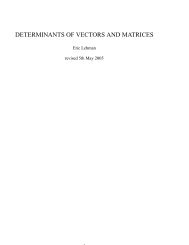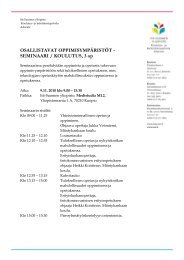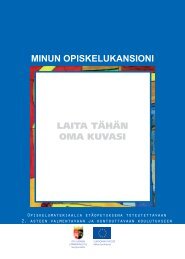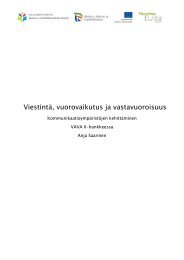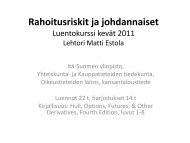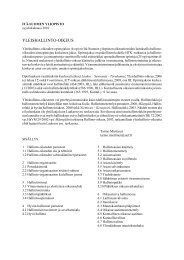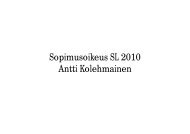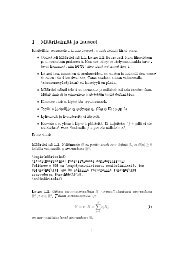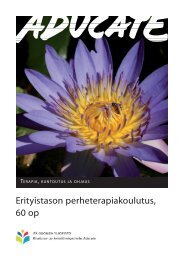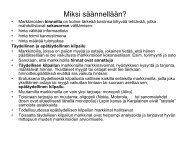Male steroid hormones and female preference for male body odor
Male steroid hormones and female preference for male body odor
Male steroid hormones and female preference for male body odor
Create successful ePaper yourself
Turn your PDF publications into a flip-book with our unique Google optimized e-Paper software.
Evolution <strong>and</strong> Human Behavior 27 (2006) 259–269<strong>Male</strong> <strong>steroid</strong> <strong>hormones</strong> <strong>and</strong> <strong>fe<strong>male</strong></strong> <strong>preference</strong><strong>for</strong> <strong>male</strong> <strong>body</strong> <strong>odor</strong>Markus J. Rantala a, * ,1 , C.J. Peter Eriksson b , Anssi Vainikka a , Raine Kortet a,2a Department of Biological <strong>and</strong> Environmental Science, University of Jyväskylä, P.O. Box 35,FIN-40014 Jyväskylä, Finl<strong>and</strong>b Department of Mental Health <strong>and</strong> Alcohol Research, National Public Health Institute, Helsinki, Finl<strong>and</strong>Initial receipt 8 September 2005; final revision received 15 November 2005AbstractIt has been suggested that human scent works as a signal in mate selection, but the empiricalevidence is scarce. Here, we examined whether women’s olfactory <strong>preference</strong>s <strong>for</strong> a man’s scent couldbe correlated with his testosterone, estradiol, or cortisol concentrations, <strong>and</strong> whether these <strong>preference</strong>schange along with the menstrual cycle. In line with previous studies, women in their most fertile periodgave the highest attractiveness ratings to all men. However, the intensity ratings by women at differentmenstrual phases did not significantly differ statistically. Interestingly, we found that cortisolconcentration in saliva correlated positively with the attractiveness but not with the intensity ratings of<strong>male</strong> T-shirt <strong>odor</strong> by all women’s groups. However, neither testosterone nor estradiol was significantlyassociated with the ratings of attractiveness or intensity. Thus, our study suggests that there could be anovel mechanism <strong>for</strong> <strong>odor</strong>-based selection in humans.D 2006 Elsevier Inc. All rights reserved.Keywords: Cortisol; Estradiol; Homo sapiens; Mate choice; Menstrual cycle; Olfaction; Phermones, Sexualselection; Testosterone4 Corresponding author. Section of Ecology, Department of Biology, University of Turku, FIN-20014 Turku,Finl<strong>and</strong>.E-mail address: marrant@cc.jyu.fi (M.J. Rantala).1 Current address: Section of Ecology, Department of Biology, University of Turku, FIN-20014 Turku,Finl<strong>and</strong>.2 Current address: BEET (Integrative Ecology Unit), Department of Biological <strong>and</strong> Environmental Sciences,University of Helsinki, Helsinki, Finl<strong>and</strong>.1090-5138/06/$ – see front matter D 2006 Elsevier Inc. All rights reserved.doi:10.1016/j.evolhumbehav.2005.11.002
260M.J. Rantala et al. / Evolution <strong>and</strong> Human Behavior 27 (2006) 259–2691. IntroductionChemical cues, such as <strong>odor</strong>s <strong>and</strong> pheromones, have been found to play an important rolein sexual selection of many species. Odors <strong>and</strong> pheromones have been shown to reflect anindividual’s health (Kavalier, Choleris, Agmo, & Pfaff, 2004; Penn & Potts, 1998) <strong>and</strong>immunocompetence in choosy <strong>fe<strong>male</strong></strong>s (e.g., Rantala, Jokinen, Kortet, Vainikka, & Suhonen,2002; Rantala, Kortet, & Vainikka, 2003). In humans, <strong>odor</strong>s can reveal the MHCcompatibility with potential mates (Jacob, McClintock, Zelano, & Ober, 2002; Wedekind& Furi, 1997; Wedekind, Seeback, Bettens, & Paepke, 1995), possibly via MHC class Ibinding lig<strong>and</strong> proteins (Leinders-Zufall et al., 2004). In addition to MHC composition, <strong>odor</strong>scan convey in<strong>for</strong>mation about a potential mate’s social or reproductive status. For example, itis suggested that 16-<strong>and</strong>rostenes, 5a-<strong>and</strong>rost-16-en-3h-ol <strong>and</strong> 5a-<strong>and</strong>rost-16-en-3-one,modulate social <strong>and</strong> sexual behavior as well as the levels of <strong>steroid</strong> <strong>hormones</strong> in circulation(see Jacob & McClintock, 2000; Meredith, 2001; Monti-Bloch, Jennnings-White, & Berliner,1998; Rothardt & Beier, 2001). Thus, circulatory <strong>hormones</strong> might contribute to thein<strong>for</strong>mation transmitted by <strong>odor</strong>s.It has been suggested that whereas men rate visual appearance <strong>and</strong> <strong>odor</strong> of a mate assomewhat equally important, women may find olfactory cues of a mate very important intheir sexual responsivity <strong>and</strong> mate choice (Herz & Cahill, 1997; Herz & Inzlicht, 2002).Furthermore, in experiments where women do not see the men, it has been found thatwomen in the fertile phase of their cycle prefer the <strong>body</strong> <strong>odor</strong> of dominant men (Havlicek,Roberts, & Flegr, 2005) <strong>and</strong> men with attractive faces <strong>and</strong> low fluctuating asymmetry(Gangestad & Thornhill, 1998; Rikowski & Grammer, 1999; Thornhill & Gangestad,1999). These studies suggest that <strong>odor</strong>s might reflect preferable <strong>male</strong> qualities to a womanlooking <strong>for</strong> a mate. There is also evidence that olfactory sensitivity changes across themenstrual cycle <strong>and</strong> that ovulating women evaluate <strong>and</strong>rosterone (a substance that gives amusky smell to sweat; see review by Gower & Ruparelia, 1993) more favorably nearovulation (Grammer, 1993; Hummel, Gollisch, Wildt, & Kobal, 1991). Thus, it has beensuggested that symmetric <strong>male</strong>s with attractive faces have higher <strong>and</strong>rostenol levels (e.g.,Gangestad & Thornhill, 1998; Rikowski & Grammer, 1999). Androstenol, a chemicalprecursor of <strong>and</strong>rosterone, is a major contributor to <strong>body</strong> <strong>odor</strong> (Gower & Ruparelia, 1993).However, so far it is not known whether <strong>fe<strong>male</strong></strong>s judge <strong>male</strong>s differently in relation to highor low testosterone levels by using their scent.The immunocompetence h<strong>and</strong>icap hypothesis (ICHH) of sexual selection predicts that theexpression of secondary sexual traits should be positively related to the level of testosteroneor other immunosuppressive substance (Folstad & Karter, 1992). It has been found thattestosterone suppresses some parts of the immune system in mammals (reviewed, <strong>for</strong>example, by Grossman, 1985; Roberts, Buchanan, & Evans, 2004), but a number of studiessuggest that testosterone may actually have a beneficial effect on the immune system(reviewed in Miller & Hunt, 1996; Muehlenbein & Bribiescas, 2005). Thus, it has beensuggested that other potentially immunoregulatory <strong>hormones</strong>, such as the major stresshormone cortisol, might mask or augment the effects of testosterone (Muehlenbein &Bribiescas, 2005). Likewise, 17h-estradiol has been found to enhance some immune
M.J. Rantala et al. / Evolution <strong>and</strong> Human Behavior 27 (2006) 259–269 261functions (e.g., Ahmed & Talal, 1990; Olsen & Kovacs, 1996). On the other h<strong>and</strong>, recentstudies suggest that the ICHH mechanism could be mediated by stress <strong>hormones</strong> such ascorticosterone or cortisol (see Buchanan, 2000; Muehlenbein & Bribiescas, 2005; Robertset al., 2004), which, in high chronic exposure, are known to have deleterious effects onimmune function (e.g., Hillgarth & Wingfield, 1997; Padgett & Glaser, 2003). According tothe ICHH, only genetically immunocompetent (individuals with optimal MHC alleles)individuals can af<strong>for</strong>d to tolerate the costs associated with high concentrations ofimmunosuppressive <strong>hormones</strong> <strong>and</strong> thus are able to invest more on sexual advertisement<strong>and</strong> primary sexual traits (Skau & Folstad, 2004) than less immunocompetent individuals(Folstad & Karter, 1992; see also Kortet, Vainikka, Rantala, Jokinen, & Taskinen, 2003).Consequently, it has been suggested that <strong>male</strong> <strong>odor</strong> associated with circulatory levels ofimmunosuppressive <strong>hormones</strong> might contain in<strong>for</strong>mation on the presence of bgood genesQ<strong>for</strong> <strong>fe<strong>male</strong></strong>s (e.g., Gangestad & Thornhill, 1998; Rikowski & Grammer, 1999; Thornhill &Gangestad, 1999).Thus, in this study, we tested whether attractiveness or intensity of <strong>male</strong> <strong>body</strong> <strong>odor</strong> by<strong>fe<strong>male</strong></strong> raters is correlated with salivary concentrations of testosterone, estradiol, or cortisol.Concentrations of testosterone <strong>and</strong> cortisol in saliva are highly correlated with concentrationsof the respective free <strong>hormones</strong> in blood (e.g., Dabbs, 1990, 1991; Kirschbaum &Hellhammer, 1994; Wang, Plymate, Nieschlag, & Paulsen, 1981). If <strong>odor</strong>s work as honestsexual signals about <strong>male</strong> quality <strong>for</strong> choosy women, we expect to find that attractiveness of aman’s <strong>odor</strong> correlates with that man’s testosterone or cortisol levels in saliva. In addition, wetested whether women’s <strong>preference</strong> <strong>for</strong> the characteristics of <strong>male</strong> scent changes during themenstrual cycle approximated by a day of menstrual cycle-based method or by the use ofcontraceptives. We predicted that <strong>fe<strong>male</strong></strong>s should find <strong>male</strong>’s scent most attractive at the mostfertile window of their menstrual cycle.2. MethodsA total of 19 men aged 20 to 35 (mean=27.2F3.33 years) voluntarily participated in thestudy. Most of the men were students at the University of Jyv7skyl7, Finl<strong>and</strong>. As inprevious studies, <strong>body</strong> <strong>odor</strong>s were collected by bT-shirt experimentsQ (e.g., Gangestad &Thornhill, 1998; Kuukasjärvi et al., 2004; Rikowski & Grammer, 1999; Thornhill &Gangestad, 1999). The white T-shirts were prepared by washing them with nonperfumedsoap powder. Participants had been told to avoid perfumes <strong>and</strong> de<strong>odor</strong>ants on the day ofthe experiment <strong>and</strong> to refrain from smoking <strong>and</strong> eating <strong>odor</strong>ous dishes. Just be<strong>for</strong>e theexperiments, all participants received one clean T-shirt <strong>and</strong> they were required to washtheir <strong>body</strong> <strong>and</strong> hair with provided unscented soap <strong>and</strong> shampoo be<strong>for</strong>e wearing the shirt.These procedures ensured that the personal hygiene of the participants differed minimally.Each participant wore the T-shirt 5 h while watching movies in an auditorium. This wasconducted during the evening hours to control <strong>for</strong> within-day variation on hormone levels.<strong>Male</strong>s were required to wear a light disposable raincoat on top of their T-shirt in orderto prevent acquisition of other distracting scents. We collected three saliva samples from
262M.J. Rantala et al. / Evolution <strong>and</strong> Human Behavior 27 (2006) 259–269each participant: the first one at the beginning of the experiment, the second after 2.5 h,<strong>and</strong> the third at the end of the <strong>odor</strong> collection session. After sampling, all saliva sampleswere immediately frozen at 208C until assayed. At the end of this session, eachparticipant folded the T-shirt <strong>and</strong> placed it in the plastic bag; the T-shirts were then frozenat 208C <strong>for</strong> later assessments. This procedure was per<strong>for</strong>med in two parts in consecutiveweeks.The three saliva samples collected from each <strong>male</strong> participant (beginning, 2.5 h; end ofone time, 5 h) were analysed <strong>for</strong> testosterone, estradiol, <strong>and</strong> cortisol concentrations induplicates using the radioimmunoassay technique with commercial kits (DiaSorin, Italy).The average of all six (32) determinations per hormone was used in later analyses. Intraassayvariation <strong>for</strong> testosterone was 10.28%; <strong>for</strong> estradiol, 8.71%; <strong>and</strong> <strong>for</strong> cortisol, 6.06%.Seventy-six nonsmoking Caucasian women [age (meanFS.D.)=23.18F3.85 years] participatedin the study by sniffing the T-shirts (in addition to these, two women were excludedfrom the study since they reported to have extraordinarily short, 20 days, or long, 50 days,cycle length). The participants were mainly students from the Faculties of Science <strong>and</strong> Artsof the University of Jyv7skyl7. Be<strong>for</strong>e rating, women were given a brief questionnaire tofill out <strong>and</strong> asked to report their (1) age, (2) whether the woman currently used acontraceptive pill, (3) the first day of the woman’s last menstrual period, <strong>and</strong> (4) thetypical length (in days) of their menstrual cycle. The raters were instructed to pick one jarat time, open it <strong>and</strong> smell it, <strong>and</strong> rate the <strong>odor</strong> <strong>for</strong> intensity (1=not intense at all to10=very intense) <strong>and</strong> sexual attractiveness ( 5=very aversive, 0=neutral, to 5=veryattractive). It has been found that <strong>fe<strong>male</strong></strong> perception of <strong>male</strong> <strong>body</strong> <strong>odor</strong> changes with cyclephase <strong>and</strong> the use of pills (e.g., Gangestad & Thornhill, 1998; Rikowski & Grammer,1999). There<strong>for</strong>e, the included <strong>fe<strong>male</strong></strong> raters having average phase length 28.41F2.91 days(meanFS.D.; min 21, max 38 days) were divided into four groups: noncontraceptive users:in (1) the follicular phase (days from the first day of the cycle to 20th day from the end ofthe cycle, n=9), in (2) the fertile phase (Days 20–14 from the end of the cycle, n=11), in(3) the luteal phase (the last 14 days of the cycle, n=16); <strong>and</strong> (4) contraceptive users(n=40). This method to assign women to groups is based on the in<strong>for</strong>mation that the lutealphase lasts usually 14 days, <strong>and</strong> fertile period does not exceed 6 days (Dunson, Baird,Wilcox, & Weinberg, 1999).Relationships of <strong>male</strong> <strong>hormones</strong> with <strong>fe<strong>male</strong></strong> scores were analysed using Spearman’srank correlation. Pearson’s product moment correlation was used to study correlationsbetween hormone concentrations. p All variables (testosterone after it was trans<strong>for</strong>med usingthe equation: the x ¼ffiffiffiffiffiffiffiffiffiffiffiffiffiffiffiffiffiffilnðx þ 1Þ) were normally distributed according to Kolmogorov–Smirnov test of normality. However, nonparametric tests were used because the rankingscale between women is rather ordinal than true ratio scale, <strong>and</strong> nonparametric statisticsshould yield better reliability in such cases. Friedman’s test with Tukey’s honest significantdifference (HSD) tests <strong>for</strong> several dependent samples was used to analyse differencesbetween women’s groups if Friedman’s nonparametric ANOVA indicated significantdifferences among groups. Wilcoxon’s signed rank sum test was used to compare theattractiveness <strong>and</strong> intensity ratings by contraceptive users <strong>and</strong> noncontraceptive users acrossmenstrual phases.
264M.J. Rantala et al. / Evolution <strong>and</strong> Human Behavior 27 (2006) 259–2693. ResultsThe mean testosterone, estradiol, <strong>and</strong> cortisol concentrations measured in saliva were0.33F0.34 ng ml1 , 8.36F3.42 pg ml1 , <strong>and</strong> 6.47F2.30 Ag l1 (meanFS.D.), respectively,which represent normal saliva values <strong>for</strong> adult men (e.g., Penton-Voak <strong>and</strong> Chen, 2004; Wolf,Schommer, Hellhammer, McEwen, & Kirchbaum, 2001; Wynne-Edwards, 2001).Testosterone <strong>and</strong> estradiol were not correlated significantly with either the intensity or theattractiveness of the T-shirts (Table 1). Instead, salivary cortisol concentration stronglycorrelated positively with women’s rating of <strong>male</strong> scent attractiveness in all women’s groups(Table 1, Fig. 1), but not with intensity ratings in any women’s groups (Table 1). Testosteroneconcentration did not correlate significantly with estradiol (Pearson’s r= .308, N=19,p=.199), but the correlation with cortisol was nearly significant (Pearson’s r=.439, N=19,p=.060). Estradiol did not correlate with cortisol (Pearson’s r= .328, N=19, p=.171).Average <strong>male</strong> scent attractiveness ratings of women not using contraceptive pills showedsignificant variation across the menstrual cycle (Friedman’s test, v 2 (2) =8.00, p=.018) (Fig. 2),<strong>and</strong> women at the most fertile phase of the cycle gave the highest ratings of attractiveness <strong>for</strong>all <strong>male</strong>s (Fig. 2). Tukey’s HSD tests per<strong>for</strong>med post hoc indicated that all groups differedfrom each other at the .05 level (minimum significant difference between rank sums, 14.43;lowest observed difference, 71.00).Average <strong>male</strong> scent intensity ratings of women not using contraceptive pills did not changeduring the cycle (Friedman’s test, v 2 (2) =4.53, p=.104) (Fig. 2).Average attractiveness ratings did not differ significantly between women using contraceptivepills <strong>and</strong> women not using contraceptive pills (Wilcoxon’s test Z= 1.13, p=.260).Fig. 1. Relationship between <strong>male</strong> (N=19) saliva cortisol concentration <strong>and</strong> average attractiveness rating of aman’s T-shirt by <strong>fe<strong>male</strong></strong> raters at different phases of their menstrual cycle (number of <strong>fe<strong>male</strong></strong>s per group: follicularphase, 9; fertile phase, 11; luteal phase, 16; <strong>and</strong> contraceptive users, 40).
M.J. Rantala et al. / Evolution <strong>and</strong> Human Behavior 27 (2006) 259–269 265Fig. 2. Average attractiveness ratings of a man’s T-shirt by <strong>fe<strong>male</strong></strong> raters at different phases of their menstrualcycle. Number of women in each group is given in parentheses.However, women using contraceptive pills gave, on average, higher intensity ratings thannormally ovulating women (Wilcoxon’s test Z= 1.97; p=.049; meanFS.D., 3.18F0.98 vs.2.97F1.18, respectively).4. DiscussionInterestingly, we found a positive correlation between salivary cortisol level <strong>and</strong>attractiveness ratings of men’s T-shirts by all women’s groups, but no significant evidencethat the primary <strong>and</strong>rogen, testosterone, could be associated with the <strong>odor</strong> of a man. Thus,in the light of our study it seems that either cortisol or some other hormone connected tothe cortisol metabolism may shape the attractiveness of <strong>body</strong> <strong>odor</strong>s in humans. Forexample, several <strong>and</strong>rogens <strong>and</strong> cortisol are metabolised from the same precursor,pregnenolone (e.g., Nussey & Whitehead, 2001). Further studies are needed to confirmour result.Recently, it has been found that several women’s <strong>preference</strong>s—<strong>male</strong>s with a masculineface (Johnston, Hagel, Franklin, Fink, & Grammer, 2001; Penton-Voak & Perret, 2000;Penton-Voak et al., 1999), <strong>body</strong> <strong>odor</strong> of symmetric men (Gangestad & Thornhill, 1998), <strong>body</strong><strong>odor</strong> of men with immunocompetent genotypes (Thornhill et al., 2003), <strong>and</strong> masculinebehavioral displays (Gangestad, Simpson, Cousins, Garver-Apgar, & Christensen, 2004)—change across the menstrual cycle. However, we did not find evidence that the <strong>preference</strong> <strong>for</strong>high saliva cortisol levels changed significantly during the cycle, but all groups of womenseemed to prefer <strong>male</strong>s with high cortisol levels.
266M.J. Rantala et al. / Evolution <strong>and</strong> Human Behavior 27 (2006) 259–269Why did women prefer the <strong>odor</strong>s of men who had high cortisol level? Physiologically, it ispossible that cortisol has either a direct or indirect link via adrenalin to the activity of theapocrine sweat gl<strong>and</strong>s which might have effects on the attractiveness of <strong>body</strong> <strong>odor</strong> (Ikai &Hasegawa, 1971; Rothardt & Beier, 2001). Further, metabolism of sweat by commensalmicrobes might make the individual’s <strong>odor</strong> more pleasant depending on sweating rate (see,<strong>for</strong> example, Austin & Ellis, 2003; Stoddart, 1991). Evolutionarily, immunosuppressive<strong>hormones</strong> are said to be essential <strong>for</strong> the production of good-quality sperm since haploidsperm might be susceptible to autoimmune attacks (Skau & Folstad, 2004). Thus, bypreferring the scent of cortisol, women might be able to gain both good sperm <strong>and</strong> goodimmune genes <strong>for</strong> their offspring since only genetically immunocompetent <strong>male</strong>s would beable to maintain high cortisol levels (Folstad & Karter, 1992). Un<strong>for</strong>tunately, we were notable to measure the amount of perspiration in this study. However, it is important to note thatcortisol concentration did not correlate with the intensity ratings of T-shirts, suggesting thatcortisol affects the scent qualitatively, not quantitatively. Also, it is possible that some of thestudied men might have experienced stress, which could affect their cortisol values. Althoughthe experimental conditions were the same <strong>for</strong> all participants <strong>and</strong> were planned to be aspleasant as possible.Women’s self-reported sexual desire has been reported to peak at the fertile phase of themenstrual cycle (see, <strong>for</strong> example, Regan, 1996), when women also exhibit an increasedolfactory sensitivity (Doty, 1981; Kohl & Francoeur, 1995). Thus, as indicated in our study, itis likely that the average attractiveness rating of <strong>male</strong> scent by women not using contraceptivepills changes across the cycle, showing the highest attractiveness at the fertile phase of thecycle. However, the average intensity ratings of women did not change during the cycleamong women not using contraceptive pills. The use of contraceptive pills affected theaverage intensity ratings when analysed as overall difference between contraceptive users <strong>and</strong>nonusers, suggesting that pills might, in some circumstances, increase the olfactorysensitivity. In this study, we did not collect menstrual cycle diaries or measure salivaryestradiol <strong>and</strong> progesterone. Thus, these results may suffer from some uncontrolled variation inthe exact timing of ovulation <strong>and</strong> fertility groups. To minimise these problems, we excludedall women who had a cycle length either shorter than 21 days or longer than 37 days.Our study suggests that women’s olfactory sensitivity to a man’s scent changes during themenstrual cycle, being highest be<strong>for</strong>e <strong>and</strong> during the fertile window of the cycle. Moreover,our results propose that cortisol or its interplay with other causal factors affecting <strong>male</strong> scentmay shape the olfactory cues of mate selection in humans. Further studies are needed toexplore the generality of this result in other taxa <strong>and</strong> the evolutionary significance of this<strong>preference</strong> to women’s fitness.AcknowledgmentsWe wish to express our gratitude to the men <strong>and</strong> women who volunteered <strong>for</strong> the study. Wethank Seppo Kuukasj7rvi, Andrey Stoehr, Annie Leonard, Christina Lynch, Ann Hedrick, <strong>and</strong>anonymous referees <strong>for</strong> helpful comments on the draft of this paper. This study was funded by
M.J. Rantala et al. / Evolution <strong>and</strong> Human Behavior 27 (2006) 259–269 267the Academy of Finl<strong>and</strong> to MJR (projects: 202624 <strong>and</strong> 207294) <strong>and</strong> RK (project: 204837), <strong>and</strong>by the Biological Interactions Graduate School of the Finnish Ministry of Education to AV.ReferencesAhmed, S. A., & Talal, N. (1990). Sex <strong>hormones</strong> <strong>and</strong> the immune system—Part 2: Animal data. Bailliere’s bestpractice <strong>and</strong> research. Clinical Rheumatology, 4, 13–31.Austin, C., & Ellis, J. (2003). Microbial pathways leading to <strong>steroid</strong>al malodour in the axilla. The Journal ofSteroid Biochemistry <strong>and</strong> Molecular Biology, 87, 105–110.Buchanan, K. L. (2000). Stress <strong>and</strong> the evolution of condition-dependent signals. Trends in Ecology <strong>and</strong>Evolution, 15, 156–160.Dabbs, J. M. (1990). Salivary testosterone measurements: Reliability across hours, days, <strong>and</strong> weeks. Physiology<strong>and</strong> Behaviour, 48, 83–86.Dabbs, J. M. (1991). Saliva testosterone measurements: Collecting, storing, <strong>and</strong> mailing saliva samples.Physiology <strong>and</strong> Behaviour, 49, 815–817.Doty, R. L. (1981). Olfactory communication in humans. Chemical Senses, 6, 351–376.Dunson, D. B., Baird, D. D., Wilcox, A. J., & Weinberg, C. R. (1999). Day-specific probabilities of clinicalpregnancy based on two studies with imperfect measures of ovulation. Human Reproduction, 14, 1835–1839.Folstad, I., & Karter, A. J. (1992). Parasites, bright <strong>male</strong>s, <strong>and</strong> the immunocompetence h<strong>and</strong>icap. AmericanNaturalist, 139, 603–622.Gangestad, S. W., & Thornhill, R. (1998). Menstrual cycle variation in women’s <strong>preference</strong>s <strong>for</strong> the scent ofsymmetric men. Proceedings of the Royal Society of London Series B, 265, 927–933.Gangestad, S. W., Simpson, J. A., Cousins, A. J., Garver-Apgar, C. E., & Christensen, P. N. (2004). Women’s<strong>preference</strong>s <strong>for</strong> <strong>male</strong> behavioural displays change across the menstrual cycle. Psychological Science, 15,203–207.Gower, D. B., & Ruparelia, B. A. (1993). Olfaction in humans with special reference to odours 16-<strong>and</strong>rostenes:Their occurrence, perception <strong>and</strong> possible social, <strong>and</strong> sexual impact. Journal of Endocrinology, 137, 167–187.Grammer, K. (1993). 5-a-<strong>and</strong>rost-16en-3- a-on: A <strong>male</strong> pheromone? A brief report. Ethology <strong>and</strong> Sociobiology,14, 201–208.Grossman, C. J. (1985). Interactions between the gonadal <strong>steroid</strong>s <strong>and</strong> the immune system. Nature, 18, 257–261.Havlicek, J., Roberts, S. C., & Flegr, J. (2005). Women’s <strong>preference</strong> <strong>for</strong> dominant <strong>male</strong> odour: Effects ofmenstrual cycle <strong>and</strong> relationship status. Biology Letters, 1, 256–259.Herz, R. S., & Cahill, E. D. (1997). Differential use of sensory in<strong>for</strong>mation in sexual behavior as a function ofgender. Human Nature, 8, 275–286.Herz, R. S., & Inzlicht, M. (2002). Sex differences in response to physical <strong>and</strong> social factors involved in humanmate selection: The importance of smell <strong>for</strong> women. Evolution <strong>and</strong> Human Behaviour, 23, 359–364.Hillgarth, N., & Wingfield, J. C. (1997). Parasite-mediated sexual selection: Endocrine aspects. In D. Clayton, &E. Moore (Eds.), Host-parasite evolution: General principles <strong>and</strong> avian models (pp. 78–104). Ox<strong>for</strong>d7 Ox<strong>for</strong>dUniversity Press.Hummel, T., Gollisch, R., Wildt, G., & Kobal, G. (1991). Changes in olfactory perception during the menstrualcycle. Experientia, 47, 712–715.Ikai, K., & Hasegawa, Y. (1971). Diagrammatic representation of adrenalin sweating in human eccrine sweatgl<strong>and</strong>s. International Journal <strong>for</strong> Bometerology, 15, 292–297.Jacob, S., & McClintock, M. K. (2000). Psychological state <strong>and</strong> mood effects of <strong>steroid</strong>al chemosignals in women<strong>and</strong> men. Hormones <strong>and</strong> Behaviour, 37, 57–78.Jacob, S., McClintock, M. K., Zelano, B., & Ober, C. (2002). Paternally inherited HLA alleles are associated withwomen’s choice of <strong>male</strong> <strong>odor</strong>. Nature Genetics, 30, 175–179.Johnston, V. S., Hagel, R., Franklin, M., Fink, B., & Grammer, K. (2001). <strong>Male</strong> facial attractiveness: Evidence <strong>for</strong>a hormone-mediated adaptive design. Evolution <strong>and</strong> Human Behaviour, 22, 251–267.
268M.J. Rantala et al. / Evolution <strong>and</strong> Human Behavior 27 (2006) 259–269Kavalier, M., Choleris, E., Agmo, A., & Pfaff, D. W. (2004). Olfactory-mediated parasite recognition <strong>and</strong>avoidance: Linking genes to behaviour. Hormones <strong>and</strong> Behaviour, 46, 272–283.Kirschbaum, C., & Hellhammer, D. (1994). Saliva cortisol psychoneuroendrocrine research: Recent developments<strong>and</strong> applications. Psychoneuroendocrinology, 19, 313–333.Kohl, J. V., & Francoeur, R. T. (1995). The Scent of Eros. New York7 Continuum.Kortet, R., Vainikka, A., Rantala, M. J., Jokinen, I., & Taskinen, J. (2003). Sexual ornamentation, <strong>and</strong>rogens <strong>and</strong>papilostomasis in roach (Rutilus rutilus). Evolutionary Ecology Research, 5, 411–419.Kuukasj7rvi, S., Eriksson, C. J. P., Koskela, E., Nissinen, K., Mappes, T., & Rantala, M. J. (2004). Attractivenessof women <strong>body</strong> odours along menstrual cycle: The role of oral contraceptives <strong>and</strong> receiver sex. BehavioralEcology, 15, 579–584.Leinders-Zufall, T., Brennan, P., Widmayer, P., Ch<strong>and</strong>ramani, S. P., Maul-Pavicic, A., J7ger, M., Li, X. -H., Breer,H., Zufall, F., & Boehm, T. (2004). MHC class I peptides as chemosensory signals in the vomeronasal organ.Science, 306, 1033.Meredith, M. (2001). Human vomeronasal organ function: A critical review of best <strong>and</strong> worst cases. ChemicalSenses, 25, 369–380.Miller, L., & Hunt, J. S. (1996). Sex <strong>steroid</strong> <strong>hormones</strong> <strong>and</strong> macrophage function. Life Sciences, 59, 1–14.Monti-Bloch, L., Jennings-White, C., & Berliner, D. L. (1998). The human vomeronasal system: A review. Annalsof the New York Academy of Sciences, 855, 373–389.Muehlenbein, M. P., & Bribiescas, R. G. (2005). Testosterone-mediated immune functions <strong>and</strong> <strong>male</strong> life histories.American Journal of Human Biology, 17, 527–558.Nussey, S., & Whitehead, S. (2001). Endocrinology, an integrated approach. Ox<strong>for</strong>d7 BIOS Scientific Publishers.Olsen, N. J., & Kovacs, W. J. (1996). Gonadal <strong>steroid</strong>s <strong>and</strong> immunity. Endocrine Reviews, 17, 64–102.Padgett, D. A., & Glaser, R. (2003). How stress influences the immune system. Trends in Immunology, 24,444–448.Penn, D., & Potts, W. (1998). Chemical signals <strong>and</strong> parasite-mediated sexual selection. Trends in Ecology <strong>and</strong>Evolution, 13, 391–396.Penton-Voak, I. S., & Chen, J. Y. (2004). High salivary testosterone is linked to masculine <strong>male</strong> facial appearancein humans. Evolution <strong>and</strong> Human Behavior, 25, 229–241.Penton-Voak, I. S., & Perret, D. I. (2000). Fe<strong>male</strong> <strong>preference</strong> <strong>for</strong> <strong>male</strong> faces changes cyclically: Further evidence.Evolution <strong>and</strong> Human Behaviour, 21, 39–48.Penton-Voak, I. S., Perrett, D. I., Castles, D. L., Kobayashi, T., Burt, D. M., Murray, L. K., & Minamisawa, R.(1999). Menstrual cycle alters face <strong>preference</strong>. Nature, 399, 741–742.Rantala, M. J., Jokinen, I., Kortet, R., Vainikka, A., & Suhonen, J. (2002). Do pheromones revealimmunocompetence? Proceedings of the Royal Society of London Series B, 269, 1681–1685.Rantala, M. J., Kortet, R., & Vainikka, A. (2003). The role of juvenile hormone in immune function <strong>and</strong>pheromone production trade-offs: A test of the immunocompetence h<strong>and</strong>icap principle. Proceedings of theRoyal Society of London Series B, 270, 2257–2261.Regan, P. C. (1996). Rhythms of desire: The association between menstrual cycle phases <strong>and</strong> <strong>fe<strong>male</strong></strong> sexual desire.Canadian Journal of Human Sexuality, 5, 145–156.Rikowski, A., & Grammer, K. (1999). Human <strong>body</strong> odour, symmetry <strong>and</strong> attractiveness. Proceedings of the RoyalSociety of London Series B, 266, 869–874.Roberts, M. L., Buchanan, K. L., & Evans, M. R. (2004). Testing the immunocompetence h<strong>and</strong>icap hypothesis: Areview of the evidence. Animal Behaviour, 68, 227–239.Rothardt, G., & Beier, K. (2001). Peroxisomes in the apocrine sweat gl<strong>and</strong>s of the human axilla <strong>and</strong> their putativerole in pheromone production. Cellular & Molecular Life Sciences, 58, 1344–1349.Skau, P. A., & Folstad, I. (2004). Does immunity regulate ejaculate quality <strong>and</strong> fertility in humans? BehaviouralEcology, 16, 410–416.Stoddart, D. M. (1991). The scented ape. The biology <strong>and</strong> culture of human odour. Cambridge, MA7 CambridgeUniversity Press.
M.J. Rantala et al. / Evolution <strong>and</strong> Human Behavior 27 (2006) 259–269 269Thornhill, R., & Gangestad, S. W. (1999). The scent of symmetry: A human sex pheromone that signals fitness?Evolution <strong>and</strong> Human Behaviour, 20, 175–201.Thornhill, R., Gangestad, S. W., Miller, R., Scheyd, G., McCollough, J. K., & Franklin, M. (2003). Majorhistocompatibility complex genes, symmetry, <strong>and</strong> <strong>body</strong> scent attractiveness in men <strong>and</strong> women. BehaviouralEcology, 14, 668–678.Wang, C., Plymate, S., Nieschlag, E., & Paulsen, C. (1981). Salivary testosterone in men: Further evidence of adirect correlation with free serum testosterone. Journal of Clinical Endrocrinology <strong>and</strong> Metabolism, 53,1021–1024.Wedekind, C., & Furi, S. (1997). Body odour <strong>preference</strong>s in men <strong>and</strong> women: Do they aim <strong>for</strong> specificMHC combinations or simply heterozygosity? Proceedings of the Royal Society of London Series B, 264,1471–1479.Wedekind, C., Seeback, T., Bettens, F., & Paepke, A. J. (1995). MHC-dependent mate <strong>preference</strong>s in humans.Proceedings of the Royal Society of London Series B, 260, 245–249.Wolf, O. T., Schommer, N. C., Hellhammer, D. H., McEwen, B. C., & Kirchbaum, C. (2001). The relationshipbetween stress induced cortisol levels <strong>and</strong> memory differs between men <strong>and</strong> women. Psychoneuroendocrinology,26, 711–720.Wynne-Edwards, K. E. (2001). Hormonal changes in mammalian fathers. Hormones <strong>and</strong> Behaviour, 40,139–145.



